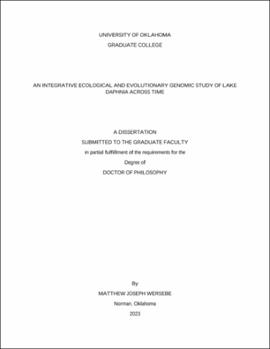| dc.description.abstract | An undisputable fact of the modern age is that human activities are now a major force shaping the biosphere. Some have called for a new geological epoch called the “Anthropocene” or the age of humans— the search is underway for a reliable and unambiguous mark in the geological record for the designation of this new epoch. As a biologist, however, I am reminded daily of the “marks” this age has left on the world around us. The American philosopher and ecologist Aldo Leopold perhaps said it best when he described an “ecological education” as “living alone in a world of wounds.” What follows in this dissertation is maybe best described as searching for wounds, for marks, in biological archives that allow us to better understand the ecosystems of the Anthropocene.
My dissertation is focused primarily on studying the widespread crustacean zooplankter, Daphnia pulicaria. A common refrain in the following chapters will be to point out the function of this and related species in lake ecosystems and their value to the humans that enjoy and benefit from lakes. Daphnia in lakes are important for two reasons; first, they are keystone species of the pelagic food webs, connecting primary production from algae to higher trophic levels namely fish. Daphnia thus support the recreational and commercial fisheries of freshwater lakes. A knock-on benefit of Daphnia trophic position is they control the standing crop of algae in freshwater ecosystems and maintain water clarity, so lakes are not choked with noxious algal blooms. My dissertation is separated into three chapters. In the first chapter, I sequence, assemble, and annotate a genome for D. pulicaria using the latest long-read DNA sequencing technology. We use the genomic resources developed for this species to better understand its evolutionary history, especially its split from the closely related “sister” species D. pulex. This reference genome is important for enabling other work, a thread we pick up in the third and final chapter.
In my second chapter, I chronicled the 175-years history of D. pulicaria and other Daphnia species in a small lake that will be the primary focus of the last two chapters. Tanners Lake is an ecosystem replete with wounds from the numerous human activities that dominate the landscape surrounding it. Due to their landscape position, lakes integrate vast amounts of information about their watersheds in their sediments. Tanners Lake records in its sediments the history of a landscape dominated by humans with the development of a major city surrounding it. Located just outside of Saint Paul, MN, Tanners Lake is impacted by two major human impacts inflicted on Northern Temperate Lakes. It is not only eutrophic, from the export of unprecedented amounts of nutrients but also it is severely salinized. Freshwater salinization is a consequence of the widespread use of de-icing salts on impervious surfaces such as roads and parking lots- a ubiquitous feature of human-dominated landscapes. I collected sediment cores from Tanners Lake to reconstruct the ecological dynamics of the Daphnia community across time in this lake by examining the abundance and diversity of resting eggs (encased in durable sclerotized structures called ephippia) across time in the core. I found that only modest changes in diversity and abundance occurred in the lake during salinization. This result suggests that Daphnia may be resilient to the threat of salinization- perhaps maintaining the ecosystems they support despite salinization.
The results of my second chapter set up an important question to tackle in my third chapter. Since D. pulicaria remains in Tanners Lake despite salinization, is this population evolving higher tolerance to these conditions? We tackle this question using an approach that is somewhat unique to Daphnia, by hatching the eggs contained in the ephippia from across time. This method known as Resurrection Ecology, allows us to sample individuals from across time and study their phenotypes and genotypes. I hatched Daphnia from across approximately 25 years (~1994-2019) and resequenced their genomes. In addition, we also evaluated these D. pulicaria clones for their tolerance to salinity using phenotypic (i.e., survivorship) assays. I compiled this data set together to understand the evolution of this population through time. The genomic data supports the idea that salinity is a driving force for evolution in this population. In particular, genes related to osmoregulation and salinity tolerance are enriched within the statistical outliers. The phenotypic data supported this finding, as we observed that the salinity tolerance of modern Daphnia was higher than that of the ancestors hatched from the sediment.
Interestingly, while I initially described this work as a search for ecological and or evolutionary wounds, I was surprised to find that while they exist in very real ways in the biological archives studied, they are not mortal. My research, taken together, suggests that Daphnia populations should have the potential to respond to human threats and evolve to maintain the ecosystems they support. However, this resiliency will be highly dependent on the speed and intensity of the threats that these systems will face, as well as the strength of the evolutionary forces (i.e., selection, drift, migration, mutation) that will shape the underlying genetic structure of these populations. | en_US |

